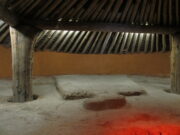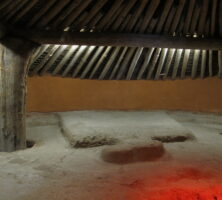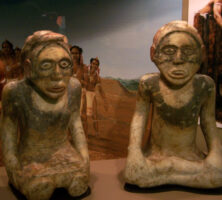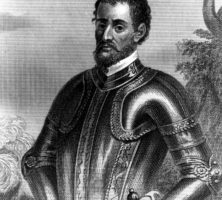The Mississippian Period in the midwestern and southeastern United States, which lasted from about A.D. 800 to 1600, saw the development of some of the most complex societies that ever existed in North America.
Mississippian people were horticulturalists. They grew much of their food in small gardens using simple tools like stone axes, digging sticks, and fire. Corn, beans, squash, sunflowers, goosefoot, sumpweed, and other plants were cultivated. They also ate wild plants and animals, gathering nuts and fruits and hunting such game as deer, turkeys, and other small animals. Mississippian people also collected fish, shellfish, and turtles from rivers, streams, and ponds.
Unlike contemporary people, Mississippian people spent much of their lives outdoors. Their houses were used mainly for shelter from inclement weather, sleeping in cold months, and storage. These were rectangular or circular pole structures; the poles were set in individual holes or in continuous trenches. Walls were made by weaving saplings and cane around the poles, and the outer surface of the walls was sometimes covered with sun-baked clay or daub. Roofs were covered with thatch, with a small hole left in the middle to allow smoke to escape. Inside the houses the hearth dominated the center of the living space. Low benches used for sleeping and storage ringed the outer walls, while short partitions sometimes divided this outer space into compartments. By today’s standards Mississippian houses were quite small, ranging from twelve feet to thirty feet on a side.
Organization of Society
The Mississippian way of life was more than just an adaptation to the landscape—it was also a social structure. Mississippian people were organized as chiefdoms or ranked societies. Chiefdoms were a specific kind of human social organization with social ranking as a fundamental part of their structure. In ranked societies people belonged to one of two groupings, elites or commoners. Elites, who made up a relatively small percentage of chiefdom populations, had a higher social standing than commoners.
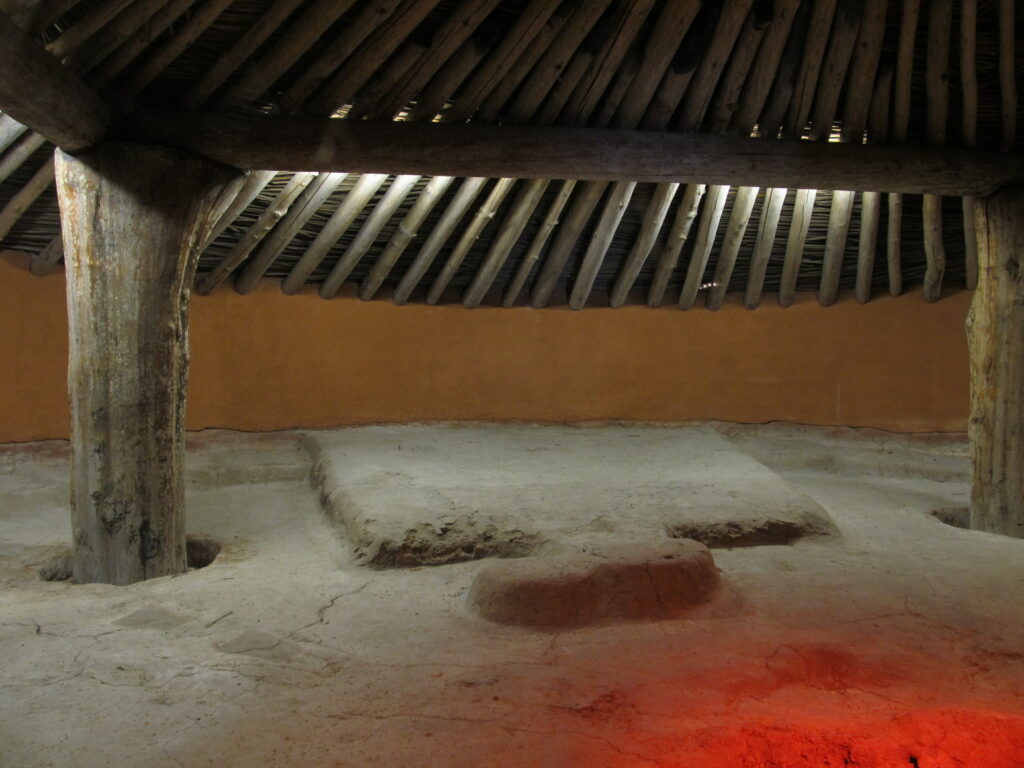
Image from Ken Lund
This difference between elites and commoners rested more on ideological and religious beliefs than on such things as wealth or military power. For example, the Natchez of Louisiana, who were still organized as a chiefdom during the early 1700s, believed that their chief and his immediate family were descended from the sun, an important god to the Natchez. It was believed that the Natchez chief, probably like most Mississippian chiefs, could influence the supernatural world and therefore had the ability to ensure that important events like the rising of the sun, spring rains, and the fall harvest came on time.
Because of these supernatural connections, elites received special treatment. They had larger houses and special clothing and food, and they were exempt from many of life’s hard labors, like food production. The much more numerous commoners were the everyday producers of the society. They grew food, made crafts, and served as warriors and as laborers for public works projects.
Settlements
Mississippian people, who were mainly farmers, often lived close to rivers, where periodic flooding replenished soil nutrients and kept their gardens productive. They lived in small villages and hamlets that rarely had more than a few hundred residents and in some areas also lived in single-family farms scattered across the landscape. Although there was a great deal of variation across Georgia, a typical Mississippian village consisted of a central plaza, residential zone, and defensive structures.
The plaza, located in the center of the town, served as a gathering place for many purposes, from religious to social. Houses were built around the plaza and were often arranged around small courtyards that probably served the households of several related families. Some, though not all, Mississippian villages also had defensive structures. Usually these took the form of a pole wall, known as a palisade; sometimes there was a ditch immediately outside the wall. These helped to keep unwelcome people and animals from entering the village.
Certain Mississippian towns featured mounds. These were made from locally quarried soils and could stand as tall as 100 feet. Most mounds were built in stages, sometimes over the course of a century or more. Although Mississippian mounds were made in various shapes, most were rectangular to oval with a flat top. These mounds were used for a variety of purposes: as platforms for buildings, as stages for religious and social activities, and as cemeteries.
Mississippian towns containing one or more mounds served as the capitals of chiefdoms. Historical and archaeological information shows that mounds were closely associated with Mississippian chiefs. Only chiefs built their houses and placed temples to their ancestors on mounds, conducted rituals from the summits of mounds, and buried their ancestors within mounds. Linguistic evidence suggests that mounds actually may have been symbols representing the earth. By using mounds as they did, Mississippian chiefs explicitly reminded their followers of their dominance over the earthly realm.
Art
Some of the most impressive achievements of Mississippian people are the finely crafted objects made of stone, marine shell, pottery, and native copper. Although they do not fit the Western conception of art, these items constitute a distinct artistic tradition. Using an essentially Stone Age technology, Mississippian people created gorgets (decorative collarpieces), cups, pendants, and beads made of marine shell. Many of the cups and gorgets bear elaborate decorations. By flaking, carving, and grinding stone materials, Mississippian people created large blades, elaborate eccentrics (artifacts of irregular shape), pipes, and effigy celts. They developed copper-working techniques to create celts, small ornaments, and large copper sheets bearing decorations like those on the gorgets and cups. This technique did not involve smelting, but instead involved the cold-hammering of native copper nuggets into thin sheets that were then shaped, cut, and embossed with designs.
These items belong to what is known as the Southeastern Ceremonial Complex (SECC). The SECC is a set of objects and symbols usually found in ritual settings or as offerings in elite graves. Rather than being art simply for the sake of art, many of these were important ritual items or parts of elite costumes. The objects themselves, or elements of their decoration, almost certainly represent supernatural beings, mythological objects, and mythical events. Their clear association with elites shows the important role elites must have played in ritual, and it also indicates how important the supernatural world was to Mississippian elites.
Mississippian Period in Georgia
In Georgia the Mississippian Period is divided into Early, Middle, and Late subperiods. The Early Mississippian subperiod (A.D. 800-1100) was the time when the first chiefdoms developed in the state.

Photograph from Wikimedia
During the Middle Mississippian subperiod (A.D. 1100-1350), large and powerful chiefdoms centered at imposing mound towns dominated the landscape. By far the largest and most impressive chiefdom capital at this time was the Etowah site, located in northwestern Georgia near Cartersville.
By the Late Mississippian subperiod (A.D. 1350-1600), the large chiefdoms of the Middle Mississippian had broken apart into smaller chiefdoms whose centers were evenly distributed across Georgia’s river valleys. Near the end of this period, from 1539 to 1543, Hernando de Soto and his army of Spaniards traveled through the Southeast in search of riches. Descriptions left behind by some of de Soto’s men tell of powerful chiefs ruling over territories that stretched for hundreds of miles. Historical and archaeological studies have identified these as paramount chiefdoms. Paramount chiefdoms were loosely united confederacies of individual chiefdoms spread over large areas. The paramount chiefdom of Coosa, described by one de Soto chronicler, had as many as seven smaller chiefdoms, all under the influence of a powerful chief living at the town also known as Coosa.

Courtesy of Georgia Info, Digital Library of Georgia.
End of the Mississippian Era
The Mississippian Period in Georgia was brought to an end by the increasing European presence in the Southeast. European diseases introduced by early explorers and colonists devastated native populations in some areas, and the desire for European goods and the trade in enslaved natives and, later, deerskins caused whole social groups to relocate closer to or farther from European settlements. The result was the collapse of native chiefdoms as their populations were reduced, their authority structures were destroyed by European trade, and their people scattered across the region. Many remnant populations came together to form historically known native groups such as the Creeks, Cherokees, and Seminoles.


